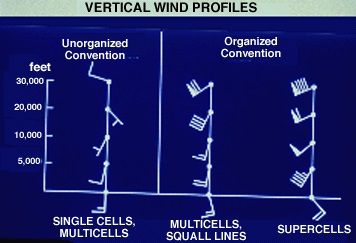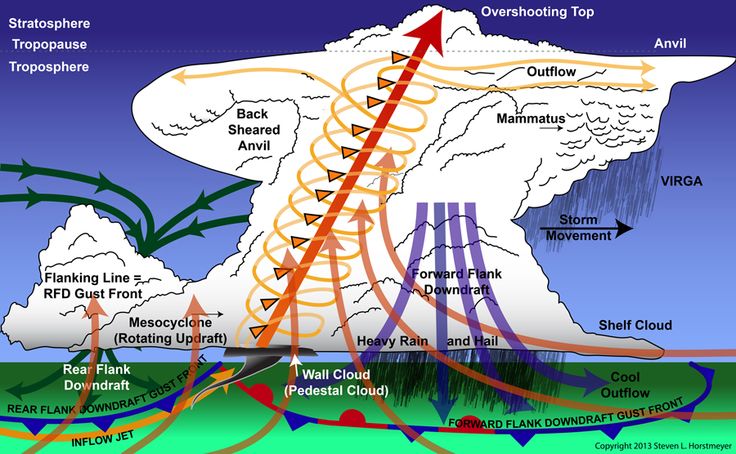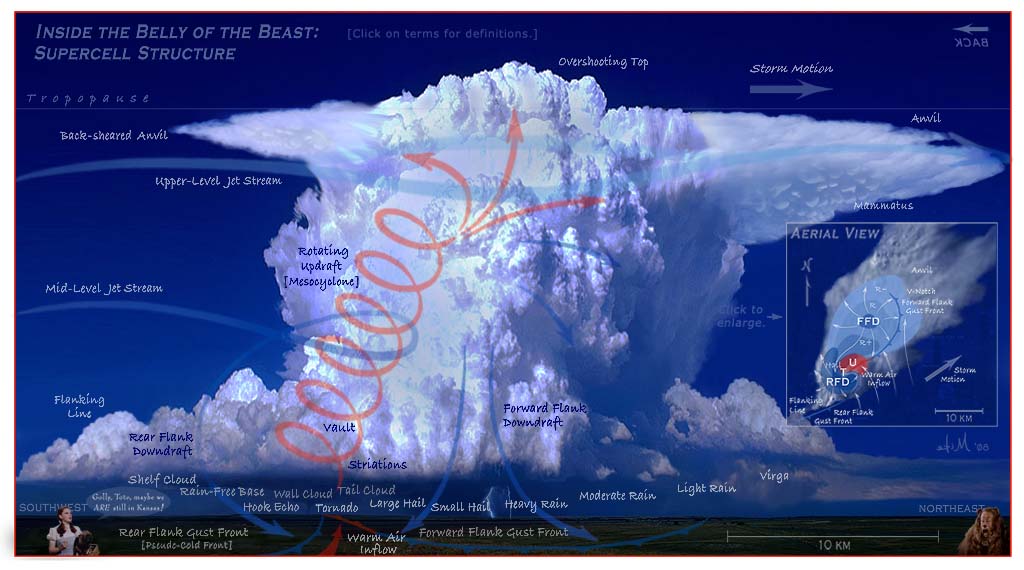| THUNDERSTORM INGREDIENTS |
theweatherprediction.com
There are three ingredients that must be present for a thunderstorm to occur. They are: MOISTURE, INSTABILITY, and LIFTING. Additionally, there is a fourth ingredient (WIND SHEAR) for severe thunderstorms and each are covered separately and in-depth farther down:
As a general rule, the surface dewpoint needs to be 55 degrees Fahrenheit or greater for a surface based thunderstorm to occur. A dewpoint of less than this is unfavorable for thunderstorms because the moist adiabatic lapse rate has more stable parcel lapse rate at colder dewpoints. Dewpoints at the surface can be less than 55 degrees Fahrenheit in the case of elevated thunderstorms.
Instability also decreases as low-level moisture decreases. Instability occurs when a parcel of air is warmer than the environmental air and rises on its own due to positive buoyancy. Instability is often expressed using positive CAPE or negative LI values. Instability is what allows air in the low levels of the atmosphere to rise into the upper levels of the atmosphere. Without instability, the atmosphere will not support deep convection and thunderstorms. Instability can be increased through daytime heating. Lift is what gives a parcel of air the impetus to rise from the low levels of the atmosphere to the elevation where positive buoyancy is realized. Very often, instability will exist in the middle and upper levels of the troposphere but not in the lower troposphere. Low level stability is often referred to as negative CAPE, convective inhibition, or the cap.
It is lift that allows air in the low levels of the troposphere to overcome low level convective inhibition. Lift is often referred to as a trigger mechanism. There are many lift mechanisms. A list of many of them follows: fronts, low level convergence, low level WAA, low level moisture advection, mesoscale convergence boundaries such as outflow and sea breeze boundaries, orographic upslope, frictional convergence, vorticity, and jet streak. All these processes force the air to rise. The region that has the greatest combination of these lift mechanisms is often the location that storms first develop. Moisture and instability must also be considered. A thunderstorm will form first and develop toward the region that has the best combination of: high PBL moisture, low convective inhibition, CAPE and lifting mechanisms.
The difference between a thunderstorm and a severe thunderstorm is the wind field. For a severe thunderstorm, the ingredients that must be present are moisture, instability, lift and strong speed and directional storm relative wind shear. Ideally, wind will have a veering directional change of 60 degrees or more from the surface to 700 millibars, upper level winds will be greater than 70 knots, and the 850 to 700 mb winds (low level jet) will be 25 knots or greater. Wind shear aids in the following: Tilting a storm (displacing updraft from downdraft), allows the updraft to sustain itself for a longer period of time, allows the development of a mesocyclone, and allows rotating air to be ingested into the updraft (tornadogenesis).
Severe storms also tend to have these characteristics over ordinary thunderstorms: higher CAPE, drier air in the middle levels of the atmosphere (convective instability), better moisture convergence, baroclinic atmosphere, and more powerful lift.
MOISTURE
Low level moisture is assessed by examining boundary layer dewpoints. Severe thunderstorms are more likely when the surface dewpoint is 55 F or higher, all else being equal. Low dewpoint values inhibit sufficient latent heat release and significantly reduce the tornado threat.
Tornadoes are more likely when the LCL is relatively low as compared to relatively high. The depth of moisture in the lower troposphere and the rate of moisture advection are also important to examine.
While a lack of moisture in the lower troposphere reduces the severe storm threat, a lack of moisture in the middle troposphere is helpful to the severe storm threat if there is abundant moisture in the lower troposphere. Convective (potential) instability is present in this situation.
The advection of higher dew point values into the boundary layer can increase instability in a severe weather situation. This is often accomplished by advection from a warm ocean source.
INSTABILITY
There are different types of instability and each one of these will be discussed. The release of instability causes air to accelerate in the vertical. This is the reason air rises so quickly to form thunderstorms. Instability is a condition in which air will rise freely on its own due to positive buoyancy. As an example, imagine a basketball at the bottom of a swimming pool. Once the basketball is released it accelerates upward to the top of the pool. The basketball rises because it is less dense than the water surrounding it. A similar process occurs when instability is released in the atmosphere. Air in the lower troposphere is lifted until it becomes less dense than surrounding air. Once it is less dense it rises on its own. The speed that is rises depends on the density difference between the air rising and the surrounding air. In any thunderstorm, rising motion is occurring since that air rising in the updraft of the storm is less dense than the surrounding air.
PARCEL INSTABILITYParcel instability (also called Static Instability) is assessed by examining CAPE and/or the Lifted Index. Two common measures of CAPE are SBCAPE (surface based CAPE) and MUCAPE (most unstable CAPE). CAPE of 1,500 J/kg is large with values above 2,500 J/kg being extremely large instability. LI values less than -4 are large with values less than -7 representing extreme instability. High instability allows for high accelerations within of the updraft. A strong updraft is important to hail generation.
LATENT INSTABILITYThis is instability caused by the release of latent heat. Latent instability increases as the average dewpoint in the PBL, or in the region that lifting begins, increases. The more latent heat that is released, the more a parcel of air will warm. If the PBL is very moist and humid, the moist adiabatic lapse rate will cause cooling with height of a rising parcel of air to be small (perhaps only 4 C/km) in the low levels of the atmosphere. A storm with an abundant amount of moisture to lift will have more latent instability than a storm that is ingesting dry air. Often storm systems and storms will intensify once they get to the east of the Rockies because more low level moisture becomes available to lift. A Nor-easter is a classic example of latent instability. Warm and moist air from the Gulf Stream or Gulf of Mexico increases latent instability.
CONVECTIVE (POTENTIAL) INSTABILITYConvective (also called potential) instability occurs when dry mid-level air advects over warm and moist air in the lower troposphere. Convective instability is released when dynamic lifting from the surface to mid-levels produces a moist adiabatic lapse rate of air lifted from the lower troposphere and a dry adiabatic lapse rate from air lifted in the middle troposphere. Over time, this increases the lapse rate in the atmosphere and can cause an atmosphere with little or no Surface Based CAPE to change to one with large SBCAPE (relative to a parcel of air lifted from the surface). Dry air cools more quickly when lifted compared to moist saturated air.
Convective instability exists when the mid-levels of the atmosphere are fairly dry and high dewpoints (and near saturated conditions) exist in the PBL. Water vapor imagery detects moisture in the 600 to 300 millibar range in the atmosphere. A dark color on water vapor imagery implies a lack of moisture in the mid and upper levels of the atmosphere. The surface, 850 mb, and 700 mb charts can be used to assess the low level moisture profile. The best way to analyze convective instability is by the use of a Skew-T diagram. A hydrolapse (rapid decrease of dewpoint with height) will exist at the boundary between the near saturated lower troposphere and dry mid-levels.
There will often be an inversion separating the dry air aloft and the moist air near the surface. The dry air aloft is commonly referred to as the elevated mixed layer (EML). This inversion is important because heat, moisture and instability can build under this "capping" inversion during the day. Once the cap breaks then explosive convection can result.
Below is a sounding displaying convective instability. The morning sounding shows no significant CAPE. However, a forecaster would expect daytime heating to increase SBCAPE. If lift also occurs in this sounding environment (from dynamic lifting mechanisms such as WAA,low level convergence, upper level divergence (e.g., jet streak, PDVA)) then CAPE will increase even further because the lifting will cool the mid-levels at a rate greater than the low levels.
LIFTING
While instability release is like a basketball rising from the bottom of a swimming pool, lifting is caused by air being forced to rise. Forced lifting is like picking up a bowling ball from the ground or doing a bench press. The object will not rise until a force causes it to rise. It is lifting not caused by the air rising on its own.
Without enough lifting, parcels of air can not be lifted to a point in the troposphere where they can rise on their own due to positive buoyancy. Instability, if it is present, can not be released without the proper amount of forced lifting for the individual situation.
LIFTING MECHANISMS1. Frontal boundaries, dry lines, and outflow boundaries (low level convergence)
2. Low level warm air advection
3. Upslope flow
4. Low pressure system (synoptic and mesoscale)
5. Differential heating along soil, vegetation, soil moisture, land cover boundaries (low level convergence)
6. Low level moisture advection
7. Differential Positive Vorticity Advection, jet streak divergence (upper level divergence)
8. Gravity wave
PRECIPITATION FROM LIFTING
Dynamic precipitation is also known as stratiform precipitation. Dynamic precipitation results from a forced lifting of air. These forcing mechanisms include processes that cause low level convergence and upper level divergence. As unsaturated air rises the relative humidity of the air will increase. Once the air saturates, continued lifting will produce clouds and eventually precipitation. Dynamic precipitation tends to have a less intense rain rate than convective precipitation and also tends to last longer. While stratiform rain is the product of lifting, convective precipitation is the product of both lifting and instability release.
VERTICAL SPEED AND DIRECTIONAL WIND SHEAR
Strong vertical wind shear is important to severe thunderstorm development. Wind shear influences a storm in potentially several ways:
VERTICAL SPEED SHEAR - Significant increase of wind speed with heightVERTICAL DIRECTIONAL SHEAR - Significant change of wind direction with height


1. A significant increase of wind speed with height will tilt a storm's updraft. This allows the updraft and downdraft to occur in separate regions of the storm the reduces water loading in the updraft. The downdraft will not cut-off the updraft and actually it will even enforce it.
2. Strong upper tropospheric winds evacuates mass from the top of the updraft. This reduces precipitation loading and allows the updraft to sustain itself.
3. Directional shear in the lower troposphere helps initiate the development of a rotating updraft. This is one component that is important to the development of a mesocyclone and the development of tornadogenesis. Strong lower tropospheric winds and directional shear together will generate high values of Helicity and thus this increases the tornado threat when severe storms develop.
4. The shear environment is important in determining the thunderstorm type. Both the vertical speed shear and directional wind shear have varying magnitudes. To simplify, we will have two categories: weak and strong. Thus, we have four combinations. Let's discuss each combination (assuming the updraft is of moderate strength for each case (moderate instability).
CASE 1: WEAK SPEED SHEAR, WEAK DIRECTIONAL SHEARA storm in this environment will move slowly and will be short lived. Since the storm moves slowly, the downdraft will cut-off the updraft and will thus diminish the storm. Storms in this environment are often termed "air mass thunderstorms" or "garden variety thunderstorms". If storms form in a moisture rich environment, rain can be heavy for brief periods of time. Severe weather is not likely.
CASE 2: STRONG SPEED SHEAR, WEAK DIRECTIONAL SHEARThis situation is often termed "unidirectional shear". The speed shear will allow the storm to move. The movement insures the storm will last longer than an airmass thunderstorm. Unidirectional shear often produces storms that form into lines (Mesoscale Convective Systems (MCS's)). Since the storm moves, outflow produces lift that enables new storms to grow on the storm's periphery. Over time, a line a storms result. These storms primarily produce small hail, weak tornadoes and heavy rain when they are associated with severe weather.
CASE 3: WEAK SPEED SHEAR, STRONG DIRECTIONAL SHEARWhen speed shear is weak the directional shear is not of significance. Storms in this environment will take on the characteristics of those in CASE 1. Hodograph wind speed will have similar pattern to CASE 1 and wind direction change with height will be high but often unorganized.
CASE 4: STRONG SPEED SHEAR, STRONG DIRECTIONAL SHEARThis situation can produce single-cell super-cells. This is the best situation in order to produce a rotating updraft. The speed shear enables the storm to move quickly and helps keep the updraft and downdraft separated while the directional shear helps rotate the updraft into the storm. These storms can produce large hail, strong tornadoes and heavy rain
Click here for a more in-depth presentation on typical hodographs associated with various storm types.WAA, CAA and Hodographs
The change in wind direction and wind speed with height gives clues to the synoptic temperature advection. A
clockwise turning of the wind with height is termed veering. Winds turn from southeasterly at the surface to
westerly aloft in a veering case. A veering wind is associated with warm air advection. The strength of the
warm air advection will depend on the strength of the wind and the amount of veering with height. If winds are
strong and southerly at the surface and from the west at 700 mb, through time the low levels of the atmosphere
will warm while the upper levels may stay near the same temperature. This will cause instability. The amount
of instability in the low levels will depend on the amount of thermal advection and the amount of veering from
the surface to the mid-levels. A veering profile is common in the warm sector of a mid-latitude cyclone. The
wind will veer with height in the vicinity of a warm front. Before warm front passage it is common for winds
to be light northerly, shift to the east, then finally shift to a southerly direction.
Winds that turn counterclockwise with height are termed a backing wind. A backing wind is associated with cold
fronts. Behind a cold front, wind will be from a northerly direction, then shift counter-clockwise to a
westerly direction with height. Keep in mind that the winds in the mid and upper levels usually have a more
westerly component than an easterly component due to the prevailing planetary scale westerlies. A backing wind
is associated with cold air advection. A backing wind in the low levels of the atmosphere is favorable for
synoptic scale sinking motion. Most rain and thunderstorms are out ahead of cold fronts. Precipitation behind
cold fronts is generally lighter or lacking all together in most situations.
A hodograph displays the wind speed and direction with height. Veering and backing of wind can be figured very
easily through the diagram. A hodograph can be used to determine most likely thunderstorm type. The low level
of the atmosphere is from the surface to 850 mb, the mid-levels from 850 to 500 mb, and the upper levels 500
to 150 mb. These hodograph types are described below:
SUPERCELL
MULTICELLS
AIR MASS STORMS
Click here for a more in-depth presentation on typical hodographs associated with various storm types.


